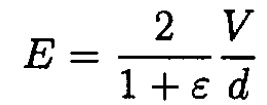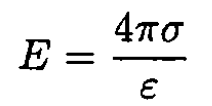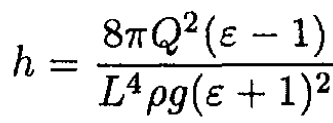
Parallel Plate Capacitor in Dielectric Bath
 المؤلف:
Sidney B. Cahn Boris E. Nadgorny
المؤلف:
Sidney B. Cahn Boris E. Nadgorny
 المصدر:
A GUIDE TO PHYSICS PROBLEMS
المصدر:
A GUIDE TO PHYSICS PROBLEMS
 الجزء والصفحة:
part 1 , p 50
الجزء والصفحة:
part 1 , p 50
 11-8-2016
11-8-2016
 2747
2747
Parallel Plate Capacitor in Dielectric Bath
A parallel plate capacitor with square plates of side L and plate separation d is charged to a potential V and disconnected from the battery. It is then vertically inserted into a large reservoir of dielectric liquid with relative dielectric constant and density until the liquid fills half the space between the capacitor plates as shown in Figure 1.1.

Figure 1.1
a) What is the capacitance of the system?
b) What is the electric field strength between the capacitor plates?
c) What is the distribution of charge density over the plates?
d) What is the difference in vertical height between the level of liquid within the capacitor plates and that in the external reservoir?
SOLUTION
a) The capacitance of the parallel plate and dielectric system is simply the sum of two capacitors in parallel:

b) The charge is constant as the plates are lowered into the dielectric bath, but the potential between the plates is not. After charging, Q = C0V. Lowering the plates into the fluid to a height L/2 changes C from C0 to C0(1 + ε)/2. The new potential V' may be found from

So

Since |V| = |E| d

c) From Maxwell’s equation we find that D = 4πσ, but D = εE, so
we find that D = 4πσ, but D = εE, so

From (b), we obtain

where the fluid is between the plates. The surface charge density where there is no fluid is

d) To determine the height difference between the liquid between the plates and in the external reservoir, we consider the sum of the electrical and gravitational potential energies of the capacitor and fluid. Let the height difference be given by h and a small change in the height be produced by ζ (see Figure 1.2) . The gravitational potential energy is given by the integral


Figure 1.2
so that the total potential energy
 (1)
(1)
Again we have written the electrical potential energy in terms of the charge Q, since the potential changes as the fluid rises or falls. Writing out the capacitance, we get
 (2)
(2)
At equilibrium, the force on the liquid is zero, or the derivative of the potential energy is zero

At equilibrium, i.e., ζ = 0,
 (3)
(3)
 (4)
(4)
Rewriting (4) in terms of V, we obtain

Alternatively, we can use the result (6) and equate the force
 (5)
(5)
to the weight of the dielectric
 (6)
(6)
From (5) and (6) we find

as in (4).
 الاكثر قراءة في مواضيع اخرى
الاكثر قراءة في مواضيع اخرى
 اخر الاخبار
اخر الاخبار
اخبار العتبة العباسية المقدسة


